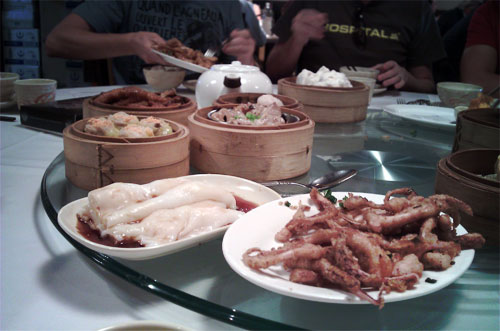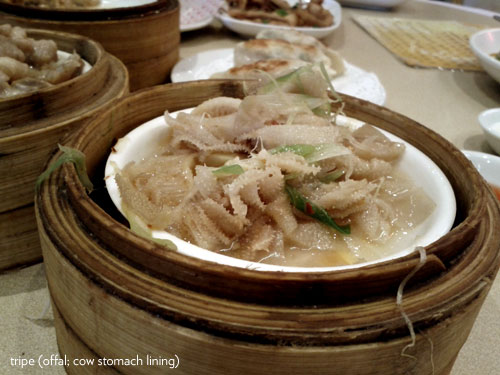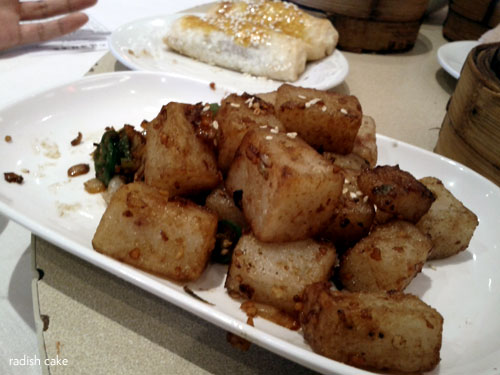Dim Sum guide for my Western friends
Just a quick reference for the basics.
My Chinese isn’t very good, and my memory is fading as I get older, so thought it prudent to create a dim sum dictionary for my hungry, aging self as well as for my western friends. The term ‘dim sum’ seems to be a Perth thing – Sydney and Melbourne people tend to call it ‘yum cha’ – but wherever you are, this rough guide is about those yummy dumplings, buns and dishes that are the best brunch.
Westerner favourites
- Crispy fried squid tentacles – yau yu sou Typically battered and deep-fried, seasoned with salt & pepper, ometimes comes with cut chilli garnish.
- BBQ pork bun – char shu bao White fluffy bread buns with sweet BBQ pork filling. The other yellowish-brown glazed bun with shortcrust-ish pastry is called
- BBQ pork bun — char shu sou These are baked, not steamed.
- Steamed pork dumplings – shu mai Pork mince dumplings with bottom & sides wrapped in wonton pastry, usually with an orange dot of roe or carrot on top.
- Shrimp dumplings – har gao Little shrimp/prawns wrapped in a thin, translucent starchy pouch. If you want to sound like a pro, order them with shu mai by saying “har gao shu mai”.
- Glutinous rice – lou mai gai (sometimes my mum calls them tsang) Sticky rice with meat & other goodies, wrapped in a lotus leaf – I’m sure I’ve had them wrapped in banana leaf once too.
- Rice porridge – jook Wet rice porridge, usually served with minced pork, chicken or egg. Should also go in the ‘weird stuff’ section, as you often get this with century egg (an acquired taste).
- Spare ribs – pai gwat Generally pork, usually about an inch long. Meat should be tender and easily fall off the bone.
Pardon the generalisation – I know non-Asians eat the weird stuff too. I’ve made these groupings based on what I see my friends order.

A selection of dim sum goodies. In the foreground are prawn cheong fan and yau yu sou; mid-ground are shu mai (lefr), feng sao (the brown one), pai gwat (right) and I’m not sure what’s behind the pai gwat, maybe a har gao; background is char shu bao (white fluffy thing).
Weird Asian stuff that Mum taught me to eat
- Chicken feet – feng sao The Chinese word translates to “phoenix claw”, but it really is just chicken feet deep-fried to soften, marinated in a tasty sauce, then steamed.
- Tripe Offal – yeah, cow stomach. It’s better than it sounds, seriously. Steamed, often served with some form of ginger, presumably to balance the aromas.
- Rice noodle rolls – cheong fan Looks nothing like a roll. It’s a wet, white steamed roll flap with meat inside. Served with sweet soy sauce. This isn’t weird at all, actually – it’s moist and unoffensive. It just looks odd to newbie eyes.
- Tofu skin roll – fu pei gwen This looks like a wet, brown roll – actually looks like a roll! It’s meat and/or veg wrapped in tofu (bean curd) skin. Again, just looks odd; the taste & texture are refreshing. Also nice to eat cold.
- Radish cake – lo baak go Cake made of shredded radish and rice flour. Potatoey texture, quite bland by itself, usually dipped in chilli oil or sauce before eating.


Types of tea
- Chrysanthemum tea – guk fa Chrysanthemum is a light and mildly fragrant tea made from chrysanthemum flower heads. Sometimes you find little petals floating in your cup. They can be nice to chew while you contemplate your wonderful meal. This and pu’erh are the 2 most common dim sum teas around here.
- Pu’erh tea – bo lay Pu’erh literally means ‘not hungry’. It’s touted for its weight loss benefits. Tastes earthy, a bit smoky – like if you made tea with dirt and grass.
- Chrysanthemum & pu’erh blend – guk bo Pu’erh tea with chrysanthemum flowers.
- Jasmine I’ve not had jasmine much with dim sum, but you can get it. Light and flowery, very distinct fragrance.
Mum always told me that drinking strong tea with your dim sum helps your body break down the fat of the food. From what I’ve learned about pu’erh tea, and tea in general, there might be some truth to this. Not to mention how crisp and fat-free your mouth feels after a hot, bitter sip of bo lay. My non-tea-drinking friends normally order Coke, which I’ve heard has ‘breaking down’ properties as well, but I prefer tea.
Desserts
- Egg dart – dan tat Egg custard resting in a little cup of flaky shortcrust-like pastry.
- Mango pudding Self-explanatory. Sometimes it’s just the pudding, sometimes you get pieces of mango in it. Sometimes served with sweet evaporated milk.
- Bubur cha cha Pinhead sized sago balls in a soup of coconut milk. Often includes little pieces of watermelon, honeydew and rockmelon. Not sure if you get this outside of Australia & South-East Asia, but most Perth dim sum places serve it. It’s awesome. Sorry, I don’t know what the English name for this is.
The story of Dim Sum
Dim sum is a breakfast/lunch type of thing, traditionally starting as early as the early morning and finishing as late as mid-afternoon. It’s a festive excuse for Chinese people – a fun way to spend time with your family and friends. When I was a kid, weekend dim sum was the highlight of our day.
Dim sum culture originated in the southern part of China, in Hong Kong, with the Cantonese folk. ‘Dim sum’ is the Cantonese word for dishes served in small portions. Enjoying these snack treats was often combined with the enjoyment of tea – the Cantonese word for which is, ‘yum cha’.
MAKES SENSE NOW, DOESN’T IT! :)